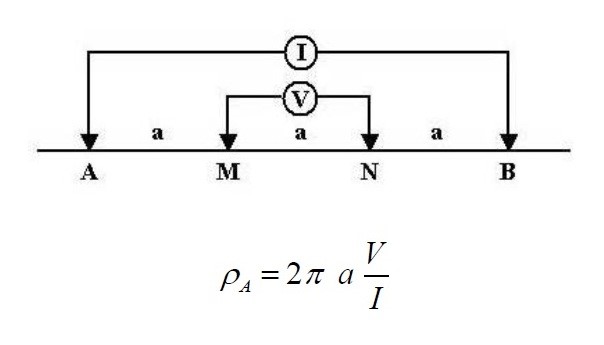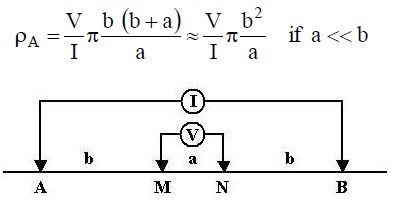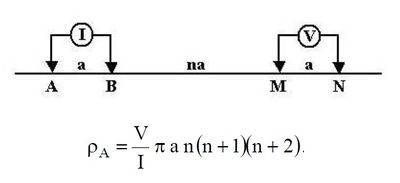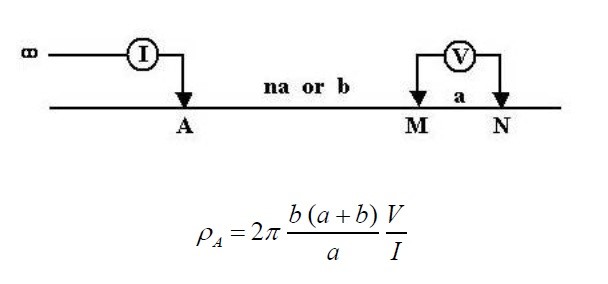Summary of different array types of electrical method
• The Wenner array is an attractive choice for a survey carried out in a noisy area (due to its high signal strength) and also if good vertical resolution is required.
• The dipole-dipole array might be a more suitable choice if good horizontal resolution and data coverage is important (assuming your resistivity meter is sufficiently sensitive and there is good ground contact).
• The Wenner-Schlumberger array (with overlapping data levels) is a reasonable allround alternative if both good and vertical resolutions are needed, particularly if good signal strength is also required.
• If you have a system with a limited number of electrodes, the pole-dipole array with measurements in both the forward and reverse directions might be a viable choice.
• For surveys with small electrode spacings and require a good horizontal coverage, the pole-pole array might be a suitable choice.
• For multi-channel arrays, the possible arrays are the multiple gradient, the dipole-dipole and pole-dipole arrays.
Wenner Array
The Wenner array consists of four collinear, equally spaced electrodes. The outer two electrodes are typically the current (source) electrodes and the inner two electrodes are the potential (receiver) electrodes. The array spacing expands about the array midpoint while maintaining an equivalent spacing between each electrode.
The advantages of the Wenner array are that the apparent resistivity is easily calculated in the field and the instrument sensitivity is not as crucial as with other array geometries. Relatively small current magnitudes are needed to produce measurable potential differences.
The disadvantages are that for each sounding, all of the electrodes have to be moved to a new position. In order to image deep into the earth, it is necessary to use longer current cables; handling the cables and electrodes between each measurement can be cumbersome, especially in difficult terrain. The Wenner array is also very sensitive to near surface in homogeneities which may skew deeper electrical responses.

Schlumberger array
The Schlumberger array consists of four collinear electrodes. The outer two electrodes are current (source) electrodes and the inner two electrodes are the potential (receiver) electrodes. The potential electrodes are installed at the center of the electrode array with a small separation, typically less than one fifth of the spacing between the current electrodes. The current electrodes are increased to a greater separation during the survey while the potential electrodes remain in the same position until the observed voltage becomes too small to measure. Typically, expanding the current electrodes occurs roughly six times per decade.
The advantages of the Schlumberger array are that fewer electrodes need to be moved for each sounding and the cable length for the potential electrodes is shorter. Schlumberger soundings generally have better resolution, greater probing depth, and less time-consuming field deployment than the Wenner array.
The disadvantages are that long current electrode cables are required, the recording instrument needs to be very sensitive, and the array may be difficult or confusing to coordinate amongst the field crew.

Schlumberger array and apparent resistivity
Dipole-dipole array
The dipole-dipole resistivity survey has been applied towards reservoir delineation as well as resistivity monitoring of a producing geothermal field. Resistivity monitoring may be sensitive to fluid extraction from the reservoir, reinjection of cooler fluids, or porosity reduction resulting from calcite precipitation.
The dipole-dipole electrode array consists of two sets of electrodes, the current (source) and potential (receiver) electrodes. A dipole is a paired electrode set with the electrodes located relatively close to one another; if the electrode pair is widely spaced it is referred to as a bipole. The convention for a dipole-dipole electrode array is to maintain an equal distance for both the current and the potential electrodes (spacing = a), with the distance between the current and potential electrodes as an integer multiple of a. The electrodes do not need to be located along a common survey line.
A primary advantage of the dipole-dipole electrode array is the ease of deployment in the field due to shorter wire lengths. However, a large generator may be needed to transmit a greater current magnitude for the measurement, especially for deep soundings.

Dipole-Dipole configuration and apparent resistivity
Pole-dipole array
The pole-dipole array contains four collinear electrodes. One of the current (source) electrodes is installed at an “effective infinity” distance, which is approximately five to ten times the survey depth. The other current electrode is placed in the vicinity of the two potential (receiver) electrodes. This geometry is utilized because it reduces the distortion of equipotential surfaces.


